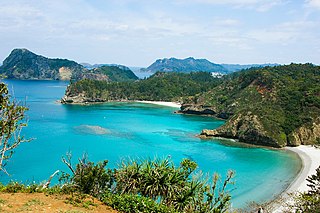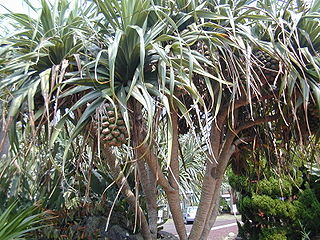
The Bonin Islands, also known as the Ogasawara Islands, are an archipelago of over 30 subtropical and tropical islands in Micronesia, some 1,000 kilometres directly south of Tokyo, Japan and 1,000 miles northwest of Guam. The name "Bonin Islands" comes from the Japanese word bunin, meaning "no people" or "uninhabited". The only inhabited islands of the group are Chichijima (父島), the seat of the municipal government, and Hahajima (母島). Archeological evidence has revealed that some of the islands may have been prehistorically inhabited by members of an unknown Micronesian ethnicity.

Hahajima is the second-largest island of the Ogasawara Islands south of the Japanese main island chain. It is about 21 km2 (8 sq mi) in area with a population of 440.

The Ogasawara subtropical moist forests is a terrestrial ecoregion which encompasses the Ogasawara Archipelago of Japan. The Ogasawara Archipelago lies in the Pacific Ocean south of Honshu, Japan's largest island, and north of the Marianas Islands. The ecoregion includes the Bonin Islands and Volcano Islands chains. The islands are volcanic in origin, and have never been linked to a continent. They are home to distinct plants and animals including many endemic species.

The Bonin thrush, also known as Kittlitz's thrush or the Bonin Islands thrush, is an extinct species of Asian thrush. It is sometimes separated as the only species of the genus Cichlopasser. The only place where this bird was found was Chichi-jima in the Ogasawara Islands; it might conceivably have inhabited Anijima and Otōtojima, but this has not been borne out by observations or specimens. The species was only once observed by a naturalist, its discoverer Heinrich von Kittlitz. He encountered the thrush in the coastal woods where it usually kept to the ground; it may have been ground-nesting. The only specimens ever taken are in the Naturalis in Leiden (1), the Naturhistorisches Museum in Vienna (1), the Senckenbergmuseum in Frankfurt (1) and in the Zoological Museum, St. Petersburg (2).

The Bonin petrel or nunulu is a seabird in the family Procellariidae. It is a small gadfly petrel that is found in the northwest Pacific Ocean. Its secretive habits, remote breeding colonies and limited range have resulted in few studies and many aspects of the species' biology are poorly known.

The Bonin white-eye or meguro (メグロ) is a small songbird endemic to the Bonin Islands of Japan. It is the only species in the genus Apalopteron. Its taxonomic affinities were a long-standing mystery and it has been placed with the bulbuls, babblers and more recently with the honeyeaters, during which it was known as the Bonin honeyeater. Since 1995 it is known to be a white-eye in the family Zosteropidae, that is closely related to the golden white-eye of the Marianas Islands.

Pandanus boninensis is an Asian species of plant that is endemic to and common in the Distylium-Schima dry forests and Raphiolepis-Livistona dry forests of the Ogasawara Islands, Japan. It has aerial prop roots and grows on rocks. The beetle, Phylloplatypus pandani is a leaf miner that consumes the leaves of P. boninensis, it was first described by scientists in 1998. The fungus, Kodonospora tetracolumnaris was isolated from dead leaves of P. boninensis and described in 1993.
Sturdee's pipistrelle, also known as the Bonin pipistrelle bat, is a bat that was thought to have lived in Japan before officially becoming extinct in 2000. In 2020 the IUCN changed its official status to "extinct".

The Bonin flying fox, Bonin fruit bat, or in Japanese Ogasawara giant bat is a species of flying fox in the family Pteropodidae. It is endemic to four islands in Ogasawara Islands, Japan. Its natural habitat is subtropical forests. It is threatened by habitat loss.

Stenomelania is a genus of freshwater snails with a gill and an operculum, aquatic gastropod mollusks in the subfamily Thiarinae of the family Thiaridae known as thiarids.
Metrosideros boninensis is a species of flowering plant in the family Myrtaceae. It is endemic to the Bonin Islands archipelago and is found exclusively on Chichijima Island, excepting for two remaining trees located on neighboring Anijima Island. M. boninensis is classified as ‘endangered’ in the Japanese Red Data Book and, although there were 326 plants recorded in 2004, genetic diversity of M. boninensis is extremely low.
Stenomelania juncea is a species of freshwater snail, an aquatic gastropod mollusk in the family Thiaridae.

Stenomelania costellaris is a species of freshwater snail, an aquatic gastropod mollusk in the family Thiaridae.

Stenomelania uniformis is a species of freshwater snail, an aquatic gastropod mollusk in the family Thiaridae.

Stenomelania aspirans is a species of freshwater snail, an aquatic gastropod mollusc in the family Thiaridae.
Livistona boninensis is a species of flowering plant in the family Arecaceae (palms), native to the Bonin Islands of Japan. It has been introduced into the Volcano Islands, also Japanese.
Malaxis boninensis is a species of flowering plants in the family Orchidaceae, native to the Bonin Islands and the Volcano Islands, both belonging to Japan. It grows on the ground from pseudobulbs. It was first described by Gen-ichi Koidzumi in 1918, as Microstylis boninensis, and transferred to Malaxis by Kunio Nakajima in 1975.
Gibbosporina is a genus of 13 species of foliose lichens in the family Pannariaceae. It contains species that molecular phylogenetic analysis clustered together in a clade previously referred to as the "Physma"-group. Despite their morphological differences, this group shares several uniting characteristics. They have ring-like excipular margins around the thallus; strongly amyloid internal ascus structures; well-developed perispores that feature irregular gibbae, but not verrucae ; lacks secondary compounds than can be detected by thin-layer chromatography; and have tropical distributions.
Gibbosporina boninensis is a species of foliose lichen in the family Pannariaceae. It was described as a new species in 1969 by Syo Kurokawa as Psoroma boninense. The type was collected on an andesite-rich rugged mountaintop of Mt. Tsutsuji in Chichijima, Japan. In 2016, Arve Elvebakk and Per Magnus Jørgensen transferred the taxon to the newly circumscribed genus Gibbosporina, of which it is the type species. The lichen occurs only in the isolated subtropical Bonin Islands, for which it is named.

The JapaneseRed List is the Japanese domestic counterpart to the IUCN Red List of Threatened Species. The national Red List is compiled and maintained by the Ministry of the Environment, alongside a separate Red List for marine organisms. Similarly drawing on the relevant scientific authorities, NGOs, and local governments, the Ministry of the Environment also prepares and publishes a Red Data Book that provides further information on species and habitats.












